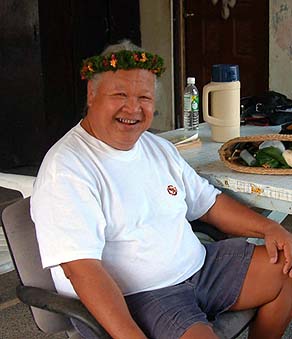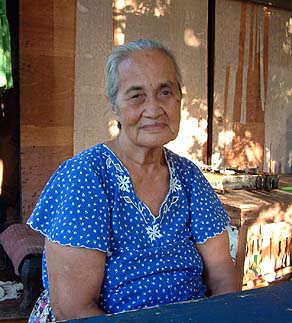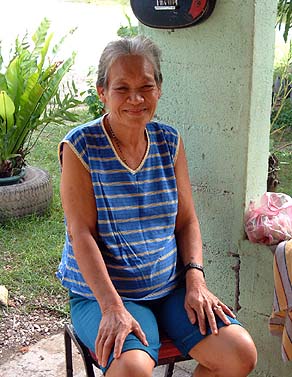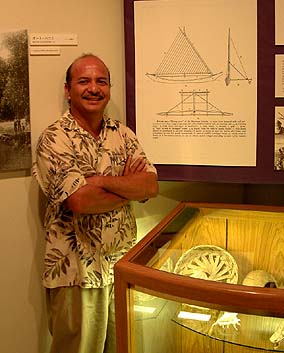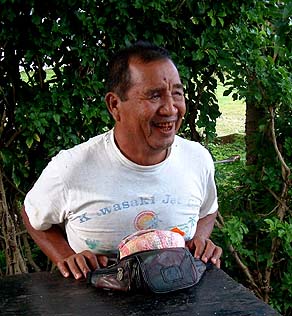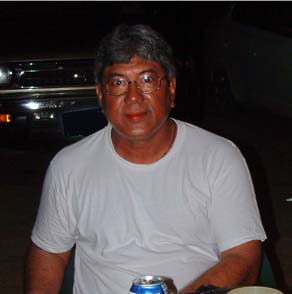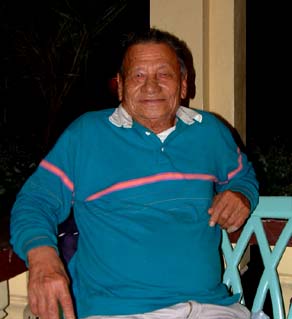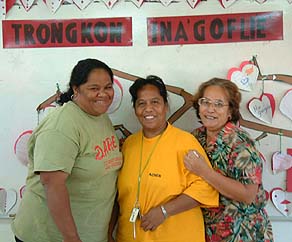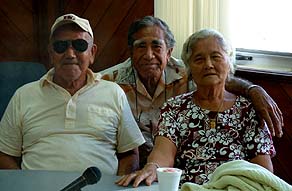 |
 |
 |
|||||
|
|
|
|
|
|
|
|
|
| Guides to Tanapag |
|
|
Pacific Worlds was very pleased to have the assistance of the CNMI Department of Education; the Historic Preservation Office; the Northern Marianas Museum; and local staff from Pacific Resources for Education and Learning (PREL) service center in Saipan. These organizations identified the following people to guide us through Tanapag and CNMI:
|
||
|
|
||
|
|
Benigno Magofna Sablan: "I live in the village of Tanapag. I am a retired person now. My last job with the government was Secretary of the Department of Lands and Natural Resources. That includes the Division of Agriculture, the Division of Parks and Recreation, Divisions of Lands and Survey, and during my tenure, the Marianas Public Land was under that department, the office of the Coastal Resource Management Office was under the Department, and the Division of Fish and Wildlife. "According to my parents, I was born in Achugao. It’s between San Roque village and Tanapag village, up in the hills. My parents were still waiting to be taken by the US Military to an encampment down in Susupe. So I was born in a cave so to speak, because there wasn’t a single house left standing right after the war. I’m happy to announce that I’m 57 this month, and happily married, with seven children."
|
| Rosa Taning Castro: "I was born in Tanapag village. My mother comes from Unoun, in the atoll of Namon Weite, and my father came from the islands in the Chuuk lagoon called Parem. Before I was married, my name was Rosa Omar Taning. My mom’s last name is Omar and my father’s last name is Taning. My married name now is Rosa Taning Castro. "I do Carolinian dance for our culture here, but I told my group recently that maybe I cannot join them to stand and dance anymore. I can help sing, and also I’m the one watching the equipment for the dance, and I’m the one who always carries something for them when they need it."
|
|

|
Juan Iguel Tenorio: "I am a resident of Tanapag since my birth until now, 54 years staying here in the village. My dad is Chamorro. My mom is a Carolinian. I was a teacher for 14 years, and I taught general courses for elementary school kids, third grade right up to around 10th. I taught at several schools: Tanapag Elementary School, Garapan Elementary, Oleai Elementary School, Hopwood Junior High School and Marianas High School, and I taught Government also at the college at one point. "Then I became a Director of the Physical Education Program, and later served as a Congressman. I am working now as the Director for the Office of Personnel Management, under the Governor.
|
| Estella Magofna Pangelinen: "My name is Estella Blas Magofna, that’s my maiden name. When I married, I became Estella Magofna Pangelinen. I was born on February 26, 1939, in the hospital in Garapan. During Japanese times I was maybe five years old. My family was from Tanapag. My father and my mother were Guamanians. My father was born in 1890 and he was 99 years old when he passed away. And my mom was born in 1895 and she was 87 years old when she passed away. "My parents moved to Saipan during the German times. They moved to Saipan because one of their brothers had sicknesses and he promised to come here, because our patron for the church here in Tanapag is Santa Remedio. That’s ‘Saint Remedy.’ I think the real name that they say is the ‘Mother of Savior for the sick and the indigent’."
|
|
|
|
Noel B. Quitugua: "I’m the Exhibit Curator, temporarily, at the Northern Marianas Museum. And I’m an artist and I’ve done a lot of research also. I have an uncle who lives in Tanapag, and every summer I used to go up to Tanapag and stay with my relatives. But my greatest mentor, shaping what I am today, was my grandfather. He was born in 1889, and he became the cook, the gardener and handyman for George Fritz during the German administration. He’s the one who actually opened up my mind. "There was one sling stone, which I found out at my house, and he told me to sit down and listen to what the story has to say. And he told me the stories that were passed on to him by his father and his grandparents and his great-grandparents, and then I started to visualize them, and started putting everything down in visual images, in drawings."
|
| Scott Russell: "I’m currently employed at the NMI Council for the Humanities as a program officer. I came as a Peace Corps volunteer back in the early 70’s. And in fact, lived in Tanapag—that was my first village where I was assigned, mostly because they knew that I was interested in spear fishing and they wanted to put me into an area where they had people that did spear fishing. I resided in the village for probably a little bit less than a year, living with the Kapileo family there. "Following the Peace Corps, I taught for a year in Mt. Carmel High School, and then I worked 20 some odd years in the Historic Preservation program, both with the Trust Territory and finally with the Northern Marianas, from which I retired in December 2001. I started here at the Council shortly thereafter. I was born in Columbus, Ohio but I grew up in Dallas, Texas."
|
|
|
|
Pedro "Pete" Teigita: "I was born here, in Saipan, and have resided in Tanapag for all of my life. I’m retired now, just raising pigs, cows, and chickens. Before, I worked for Immigration. I worked for 15 years for Immigration, four years in the Commonwealth Utility Corporation, and two years as a civilian. I grew up with my grandmother, who practiced traditional medicine. I learned from her some of the traditional medicine. And what I learned from my grandfather is how to fish, going with the old people, going out fishing. And that’s how I became a fisherman. I am of the Remar clan." "Pete Teigita would be the next chief," Ben adds, "if anything happens to our current chief, Victorino Igitol."
|
David Norita Rios: "I was born here on Saipan on April 13th 1949. Our family grew up in Tanapag, close to the beach area and there was a typhoon at that time so we eventually evacuated to the upper area where I am staying now. My mother’s side is Carolinian and my father is Chamorro. My mom was a siruhana. She could make people heal just by doing the praying.” Dan Magofna Sablan: "When I was young, my father was farming. There were some pigs, cows, goats, and chickens, so we didn’t worry about meat. We had meat and eggs already. My family is the Magofna family married to the Leitos family. It was always like one family. The farm keeps us busy at all times. It is exercise every day. But at least thirty minutes of exercising on the farm will give you more good life, longer life.”
|
Dave & Dan
|
|
Sylvestre Iguel: "I’m the Public Liaison regarding environmental problems, or toxic chemicals, for the CNMI Department of Public Health. "At the same time, I am a member of the Tanapag Action Group. This is a group of community leaders who came together on behalf of the whole community to address issues in Tanapag. We realized that we needed to form a group in order for our concerns to be heard and addressed. "I’m wearing two hats now."
|
Jesus Muña Quitugua: "I am 80 years old, and I have lived in Tanapag since 1948, married to Ben Sablan’s oldest sister. Her maiden name is Maria Magofna Sablan. And since then I have changed that to Maria Sablan Quitugua. I was born in Garapan village. I came here when I married my wife Maria. "My father went to a German school, but he did not explain to me about the German times. He was more interested in getting me to learn to work than in telling me about the German times. My father passed away during the Navy times, 1945, the U.S. military time. My mother passed away on the island of Pagan in 1938, and that’s during Japanese times."
|
|
|
Rosa Tenorio McKinney: "I’m from Tanapag Village. I wasn’t born here but I grew up in this village, right here on this beach. I left the island in 1964 and did not come back until 1980. I missed the whole transition to Commonwealth, which kind of saddened me because I’m very much into politics now. After being absent for so many years, I see a lot of changes." Isabel Norita: "Ohmsa is the Carolinian name for my father and when he arrived here, they gave him this Catholic name, Joseph. My mom’s name is Meniseibwei in Carolinian. She came from the island of Unoun on the atoll of Namon Weite. My clan is Rewiite."
|
We also hear from three language teachers at Tanapag Elementary school: Yoane Achen, Carolinian Bilingual: “I’m from Amniotes atoll in Chuuk, where the Tanapag people came from. I lived here in Tanapag for more than ten years, then I moved down to Garapan. I have family connections to people here from a long time ago, the Lieto family, from my mother’s side. I’ve been in the bilingual program for more than 13 years.” Joaquina Mendiola: “I’m actually Carolinian and my husband is Chamorro, but I’m teaching Chamorro. I’ve been in the bilingual program since 1993, and then I stopped for a while, and I just came back to work again.” Cathy Lisua: “I was born and raised here in Tanapag. My grandfather is a northern speaker from Tanapag, and my grandmother is from Oleai. We speak the southern language, we don’t speak the northern language, so I’m a fluent southern speaker. This is my second year as a bilingual teacher.”
|
|
|
Additionally we have input from some of Saipan's elders. Lino Olopai, the activities coordinator at the Man’amko Aging Center, introduces them: "We have with us Mrs. Antonio Seman, born on Saipan July 4 1927. She is at this time 75 years old; Mr. Manuel Seles, also born here on the island of Saipan, February 26, 1926. And he is now 76 years old. And Mrs. Louisa Sablan, she’s also born on the island of Saipan, May 20, 1923. She is now 79 years old."
|
|
|
||
| Follow our guides on a journey through Tanapag, and the culture and land of Saipan and the Northern Mariana Islands. Turn the page to see the location of this village.
|
||
|
|
||
|
|
|
|
|
|

|
| Tanapag Home | Map Library | Site Map | Pacific Worlds Home |
|
|
|
|

|
|
|
|||
| Copyright 2003 Pacific Worlds & Associates • Usage Policy • Webmaster |
|||
